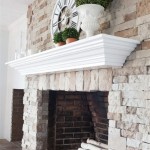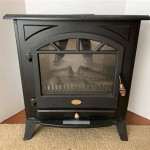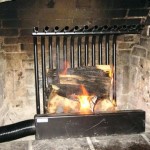Stone Veneer Fireplace Arches: Aesthetics, Construction, and Considerations
Stone veneer fireplace arches represent a convergence of architectural design and practical functionality. They provide a visually appealing focal point in a living space while simultaneously housing and framing a source of heat and ambiance. This article explores the characteristics, construction processes, and crucial considerations involved in designing and implementing a stone veneer fireplace arch.
Stone veneer, as opposed to full-depth stone, offers a lighter and more versatile material option for facing a fireplace. Its reduced weight simplifies installation and reduces the structural burden on the underlying framework. This makes it suitable for a wider array of construction projects, including retrofits where adding the weight of full stone may be structurally prohibitive. The arch, in turn, introduces a classical or rustic aesthetic, softening the lines and adding a handcrafted element to the overall design.
Aesthetic Considerations and Design Choices
The aesthetic impact of a stone veneer fireplace arch relies heavily on the selection of the stone veneer itself. Manufacturers offer a diverse range of colors, textures, and shapes. Options range from manufactured stone veneer, which provides consistent sizing and color palettes, to natural stone veneer, offering unique variations characteristic of the source quarry. The choice between these options often hinges on the desired aesthetic and budgetary constraints.
Color is a primary consideration. Darker hues like charcoal gray or deep browns often lend a sense of sophistication and grounding, while lighter tones like cream or beige can create a brighter, more airy feel. The surrounding décor and architectural style should inform this decision. A modern minimalist aesthetic might benefit from a sleek, monochromatic stone veneer, whereas a more rustic setting might favor a multi-colored blend with varied textures.
Texture plays a crucial role in defining the visual and tactile experience. Smooth, polished stone veneers project a sense of formality and refinement, while rough-hewn or stacked stone veneers evoke a more natural and rugged ambiance. The texture also affects how light interacts with the surface, influencing the perceived depth and dimension of the arch. Consider the ambient lighting in the room and how it will highlight the chosen texture.
The shape and arrangement of the stone veneer units also contribute significantly to the overall aesthetic. Linear patterns, created by using rectangular or square units, can create a sense of order and linearity. Irregular shapes and sizes, when carefully arranged, can mimic the randomness found in nature, contributing to a more organic and less formal appearance. The size and shape of the arch itself should also be considered. A wide, shallow arch creates a sense of openness, while a taller, more pointed arch adds a touch of grandeur and verticality.
Construction Process and Material Requirements
Constructing a stone veneer fireplace arch requires careful planning and execution. The process typically involves building a structural framework, applying a substrate to support the veneer, and then mortaring the stone veneer units in place. Adherence to local building codes and manufacturer specifications is paramount for ensuring structural integrity and safety.
The initial step involves building the arch form. This framework provides the shape and support for the veneer while the mortar cures. Commonly, these forms are constructed from wood. The specific design of the arch form depends on the desired arch shape and size. Accurate measurements and precise cutting are essential to create a symmetrical and stable arch form. It is prudent to consult with a qualified structural engineer or experienced contractor to ensure the form is adequately designed to handle the weight of the stone veneer.
Once the arch form is in place, a suitable substrate must be applied. This substrate provides a bonding surface for the mortar. Cement board is a frequently used option due to its durability and resistance to moisture. The cement board is typically attached to the structural framework with screws or nails. Seams between cement board sheets should be taped and mudded to create a seamless surface. This prevents cracks from forming in the veneer over time.
The application of the stone veneer involves carefully mortaring each individual unit in place. A high-quality mortar, specifically designed for stone veneer applications, is crucial for ensuring a strong and lasting bond. The mortar should be mixed according to the manufacturer's instructions and applied evenly to the back of each stone veneer unit. The units are then pressed firmly against the prepared substrate, ensuring proper alignment and spacing.
Maintaining consistent joint spacing is critical for achieving a professional and visually appealing result. Plastic spacers or shims can be used to ensure uniform joint widths. Excess mortar should be removed promptly to prevent staining the stone veneer. The mortar joints are typically "pointed" or "tooled" after the mortar has partially cured. This involves using a specialized tool to create a consistent and aesthetically pleasing profile in the mortar joints. Different tooling techniques can be employed to achieve various looks, ranging from a flush joint to a recessed or raked joint.
Critical Considerations for Safety and Long-Term Performance
Several key considerations ensure the safety, durability, and long-term performance of a stone veneer fireplace arch. These include adherence to fire safety regulations, proper ventilation, and moisture management.
Fire safety is paramount when designing and constructing any fireplace. The surrounding materials, including the stone veneer and the underlying framework, must be non-combustible or treated with fire-retardant coatings. Clearance distances between the fireplace opening and combustible materials must comply with local building codes and manufacturer specifications. A fire-resistant hearth extension is also essential to protect the surrounding floor from sparks and embers.
Proper ventilation is crucial for efficient combustion and preventing the buildup of harmful gases, such as carbon monoxide. Fireplaces should be designed with adequate airflow to ensure complete combustion and efficient venting of exhaust gases through the chimney or flue. Regular inspection and cleaning of the chimney are essential for maintaining proper ventilation and preventing chimney fires.
Moisture management is another critical aspect of ensuring the longevity of a stone veneer fireplace arch. Water penetration can damage the veneer, weaken the mortar, and cause structural problems. Proper flashing should be installed to prevent water from entering behind the veneer. A vapor barrier may also be necessary in certain climates to prevent moisture from migrating through the walls and into the veneer. Stone veneer should be selected that is appropriate for the climate and exposure conditions. Some stones are more porous than others and therefore susceptible to damage from freeze-thaw cycles.
Furthermore, the choice of fireplace insert or firebox affects the overall design and performance of the stone veneer arch. Gas fireplaces, electric fireplaces, and wood-burning fireplaces each have unique venting requirements and heat output characteristics. The stone veneer must be able to withstand the heat generated by the fireplace without cracking or discoloring. The manufacturer's specifications for the fireplace insert should be carefully reviewed to ensure compatibility with the chosen stone veneer and the overall design of the arch. Regular maintenance, including cleaning and inspection, is essential for maintaining the appearance and structural integrity of the stone veneer fireplace arch over time.

7 Popular Stone Veneer Fireplace Design Trends Mason S Mark

Stunning Dry Stack Stone Fireplace With An Arch Design

Stone Veneer Fireplaces Natural Facing

Iron Hammer Stoneworks Llc

Arched Stone Fireplace Yahoo Search Results Arquitetura Casas Recamier

Stone Fireplace Surrounds Joseph Surround Brown Sandstone Home

Stone Fireplace Palillos Masonry

How To Measure An Arch Masonry Opening For A Design Specialties Legend Fireplace Door

Natural Stone Fireplace Living Room Interior Outdoor Patio Veneers Buechel

Iron Hammer Stoneworks Llc
Related Posts








